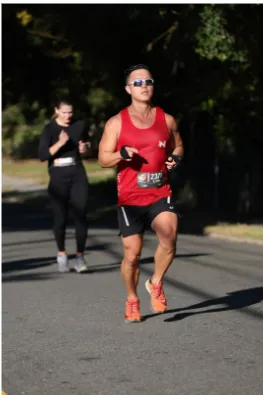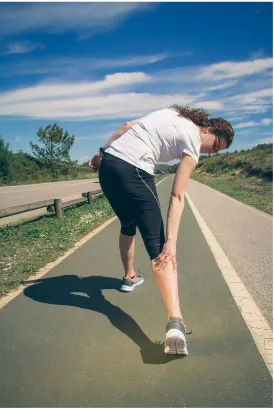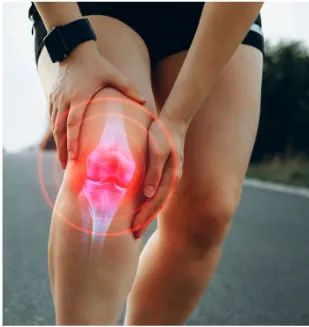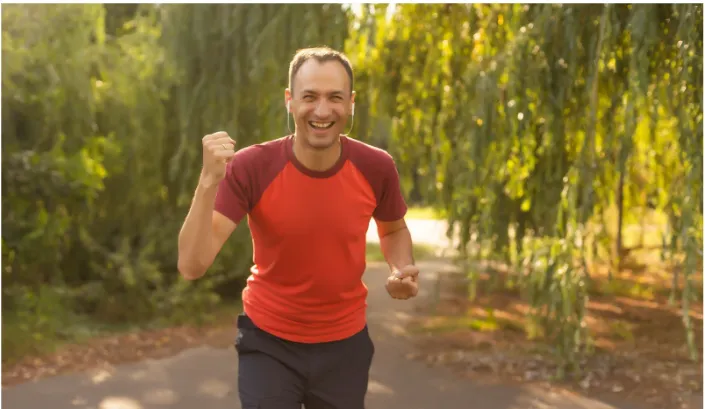Avoid Runner’s Knee! How Finding Your Perfect Cadence Can Prevent Knee Injuries
5 MINUTES READ
Key Takeaways:
The 180 SPM myth has been debunked; research now shows that the best cadence varies for each runner based on individual factors like height, speed, and biomechanics.
Finding your optimal cadence can reduce injury risk, particularly by preventing overstriding, which places excessive strain on the knee and increases the chance of issues like runner's knee.
Focusing on form over a specific number allows runners to find a natural, efficient stride that minimizes injury risk and enhances performance.

In the world of running, cadence—the number of steps taken per minute—is often a hot topic. For years, the "ideal" running cadence of 180 steps per minute (SPM) was touted as the golden standard for efficiency and injury prevention.
However, research shows that the best cadence for each runner is highly individual, and striving for an arbitrary number may not be beneficial for everyone.
Instead, finding your own optimal cadence, the one that aligns with your unique biomechanics, can make a significant difference in your performance and reduce the risk of common running injuries, including knee injuries caused by overstriding.
At Next Level Physio in Cary, >70% of the running injuries we treat are associated with running form or strength training deficits.Let’s break down the science behind running cadence, why it matters, and how adjusting your cadence could lead to a healthier, more efficient stride.
Let’s break down the science behind running cadence, why it matters, and how adjusting your cadence could lead to a healthier, more efficient stride.
The Myth of 180 SPM: One Size Doesn’t Fit All
The idea of 180 steps per minute as an ideal cadence originated with renowned running coach Jack Daniels, who observed this average cadence among elite runners during the 1984 Olympics. While many elites indeed ran at 180 SPM, further studies have revealed that running cadence is far from universal.
Elite runners’ cadences vary widely, from as low as 155 to over 200 SPM, and recreational runners typically average around 164 SPM. This variation suggests that cadence is affected by individual factors, including height, leg length, biomechanics, and even running speed. Rather than forcing yourself to run at a specific cadence, it’s more effective to find a cadence that feels efficient and comfortable for you.
Factors That Influence Your Optimal Cadence
A runner’s cadence can be influenced by multiple elements that make each individual’s stride unique. Here’s what might affect your cadence:
Height and Leg Length: Taller runners generally have a longer stride, which may naturally result in a lower cadence. Shorter runners, on the other hand, often have a quicker cadence.
Running Speed: Faster paces typically require a higher cadence. Sprinters have much quicker steps than marathon runners, which aligns with their shorter, high-speed races.
Terrain: The surface you run on can affect cadence. For instance, runners on trails might slow their cadence to navigate rough or uneven ground, while track runners often maintain a faster cadence.
Biomechanics: Natural variations in muscle strength, joint flexibility, and limb alignment impact the way each person runs, which in turn influences cadence.
Running Experience: More experienced runners may naturally develop a cadence that works best for them over time, while newer runners may still be experimenting with what feels right.

Each of these factors underscores the importance of finding a cadence that works for you rather than adhering to an arbitrary number.
The Risks of Overstriding and Knee Injuries
One of the key benefits of finding an optimal cadence is the potential to reduce overstriding, a running gait deviation that can lead to knee injuries. Overstriding occurs when your foot lands too far ahead of your body’s center of mass, creating a “braking effect.” This is problematic because it leads to several negative consequences for knee health:
Increased Impact Forces: When you overstride, your foot lands farther in front of your body, causing a braking motion. This not only slows you down but also increases impact forces on your knee joint. These forces are absorbed largely by the knee, which can result in damage over time, especially during high-mileage training.
Altered Biomechanics: Overstriding often results in landing with a straighter leg, leaving the knee more extended at initial contact. This limits the knee’s natural shock absorption capacity, placing more stress on structures like the medial collateral ligament (MCL) and potentially creating tightness in surrounding muscles and tendons.
Excessive Joint Compression: With each step, overstriding generates high compressive forces in the knee joint, which can exacerbate issues like patellofemoral pain syndrome (commonly known as runner’s knee). This syndrome occurs when the patella doesn’t track smoothly over the femur, causing pain and discomfort.
Reduced Shock Absorption: A less-flexed knee upon landing results in reduced shock absorption, placing increased stress on the knee. Over time, this stress can contribute to overuse injuries.
Altered Load Distribution: Overstriding shifts the load distribution in a way that places more stress on the knee. This can lead to various knee-related problems due to the longer “moment arm” created when the foot lands farther from the body’s center of mass.
Increased Vertical Oscillation: Overstriding often causes runners to “bounce” more, increasing the up-and-down motion of their body’s center of mass. This excess movement results in greater overall impact forces on the knees.

How Finding Your Optimal Cadence Can Help Prevent Overstriding and Knee Injuries
One of the best ways to address overstriding is by adjusting your cadence. Studies suggest that increasing cadence by just 5–10% can help runners reduce the likelihood of overstriding and decrease the impact on their knees. Here’s how an increased cadence can make a positive difference:

Reduced Ground Contact Time: A slightly higher cadence decreases the time your foot spends on the ground with each step, which can lower the impact forces transmitted to the knee. This reduces stress and may prevent injuries over time.
Better Foot Positioning: When you increase your cadence, your feet tend to land closer to your body’s center of mass. This reduces the braking effect, allowing for smoother transitions and minimizing the likelihood of overstriding.
Improved Shock Absorption: With a higher cadence, the knee is often slightly more flexed when the foot makes initial contact. This improves shock absorption, allowing your leg muscles and joints to handle impact forces more effectively and reduce knee strain
Steps to Find Your Optimal Running Cadence
Finding your optimal cadence doesn’t have to be complicated. Here’s a simple process to get started:
Measure Your Baseline Cadence: During an easy run, count your steps for one minute. This gives you a starting point.
Gradually Increase Your Cadence: If you’d like to see if a higher cadence benefits you, start by increasing it by about 5-8 SPM. Avoid large jumps, as they can feel unnatural and strain your muscles.
Focus on Form Over Numbers: Rather than obsessing over hitting an exact SPM, focus on maintaining good running form. Ensure that your foot lands closer to your body’s center of mass, maintain a slight bend in the knee at contact, and try for a midfoot strike to reduce the impact on your joints.
Listen to Your Body: Experimenting with cadence should feel comfortable and efficient. If a higher cadence feels too fast or strains your body, make smaller adjustments and focus on what feels natural to you.
What Our Clients Say
"I came to Next Level Physio with some hip flexor tightness and within minutes Dr. Jerry and his team were able to diagnose strength and running form weaknesses that I had been putting off for years. Truly professional and knowledgeable team that are so fun to be around. I wouldn’t hesitate to go back. Highly recommend to all my fitness, running, and triathlon friends." - David Wolfson
"Before discovering Next Level Physio I was no longer able to run due to a chronic hamstring injury. I had been a runner who enjoyed half marathons and regular running schedule. Then 3 half marathons in consecutive months caused a hamstring injury. It was so painful I could not even run a 5K. I had given up on being able to run again.
Then a friend recommended I see Jerry at Next Level Physio in Cary, NC. He performed a thorough assessment and started a comprehensive treatment plan. This plan was very different from a typical physical therapist. It included strengthening exercises, dry needling, shock wave therapy, and blood flow restriction. And then I was able to slowly progress to a run and walk routine without any pain! I am very grateful and strongly recommend Jerry and Next Level Physio in Cary!" - Larry Pickett
Conclusion: Prioritize Efficiency and Comfort Over the Magic Number
The concept of an "optimal" running cadence is highly individual, and the best cadence for you may not be the same as for other runners. Instead of focusing on an arbitrary number, aim to find a cadence that feels efficient, comfortable, and keeps your knees and joints healthy. Adjusting your cadence can also be a powerful tool for avoiding overstriding, reducing knee impact, and improving your overall running experience.

Remember, your cadence sweet spot might be 160, 180, or even 190 SPM. Whatever it is, listen to your body, make small adjustments, and focus on running your own race in a way that keeps you strong and injury-free.
Dealing with a nagging knee injury? Click here, if you’re curious about how Next Level Physio gets runners out of pain and helps runners stay strong and healthy during the winter months.
Happy running!
—Dr. Jerry Yoo is the Founder of Next Level Physio.He has worked with elite and professional athletes, runners, and triathletes for over 25 years. As a clinical running research partner with Rutgers University, Dr. Jerry specializes in helping runners and lifelong athletes over 40 get back to what they love to do.
References:
EndurElite. (n.d.). The 180 steps per minute running myth. NutraBio. Retrieved November 11, 2024, from https://nutrabio.com/blogs/endurelite/the-180-steps-per-minute-running-myth
Exakt Health. (n.d.). Running form mistakes that lead to injury: Tips and fixes. Exakt Health. Retrieved November 11, 2024, from https://www.exakthealth.com/en-US/blog/running-form-mistakes-that-lead-to-injury-tips-and-fixes
Macaulay, A. (2023, April 19). A beginner's guide to cadence. Runner’s World UK. Retrieved November 11, 2024, from https://www.runnersworld.com/uk/training/beginners/a772845/a-beginners-guide-to-cadence/
Mottiv. (n.d.). What is optimal running cadence and why you should care. Mottiv. Retrieved November 11, 2024, from https://www.mymottiv.com/blog/what-is-optimal-running-cadence-and-why-you-should-care
Post Address and Mail
Email: info@nlphysio.com
Address
1055 Darrington Drive
Cary, NC 27513
Get In Touch
Hours
Mon - Fri: 9:00 am- 6:00 pm
Sat: By Appointment (8:00 am - 12:00 nn)
Sun: Closed
Phone Number:
919-650-4633
Office: 1055 Darrington Drive
Cary, NC 27513
Call 919-650-4633
Email: info@nlphysio.com
Site: www.nlphysio.com

